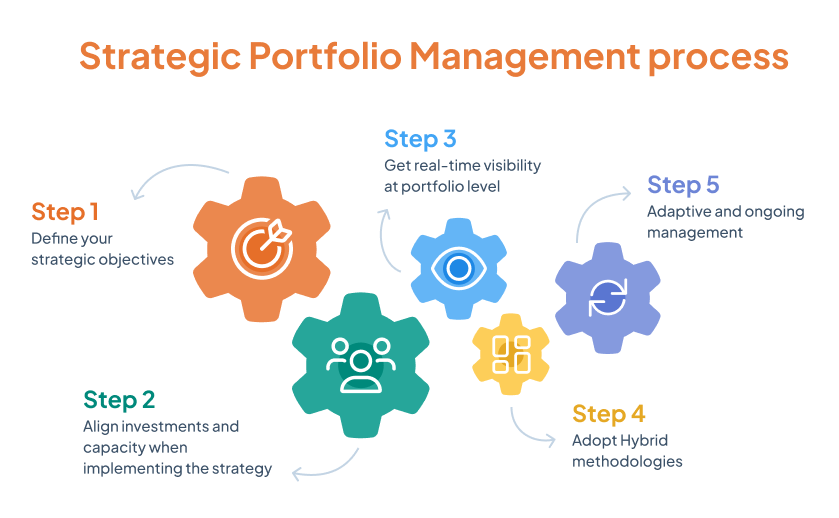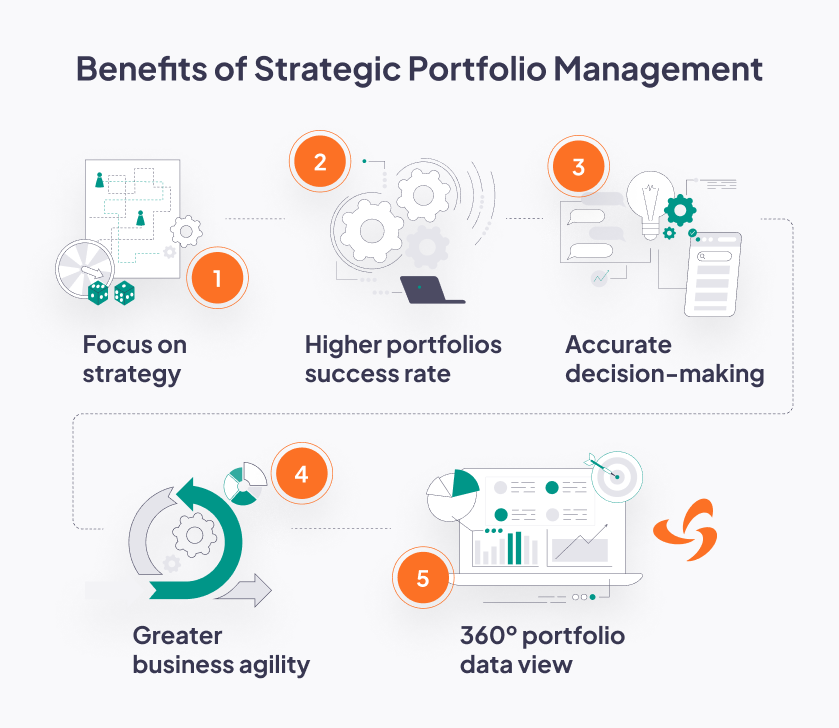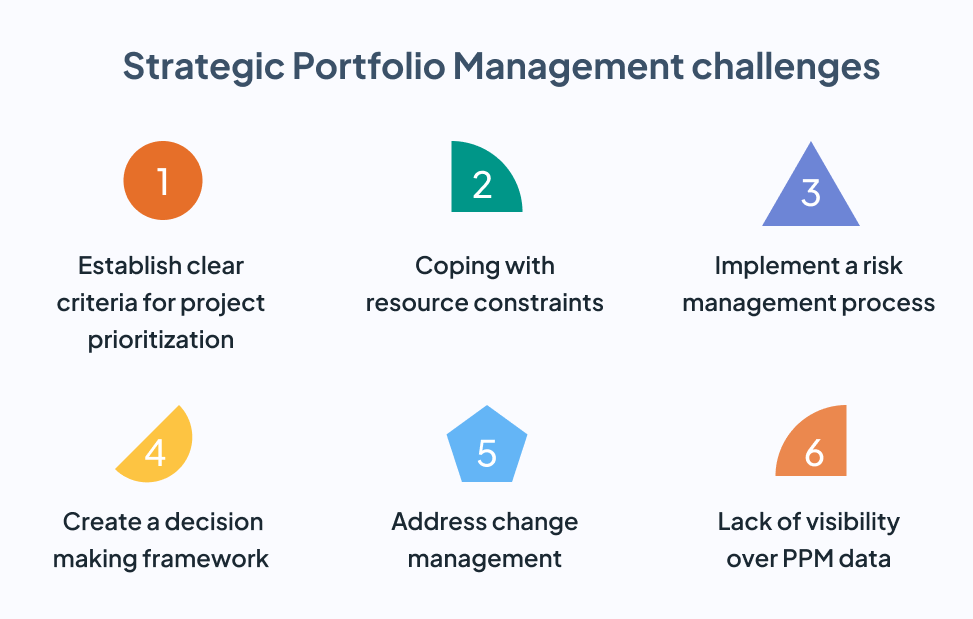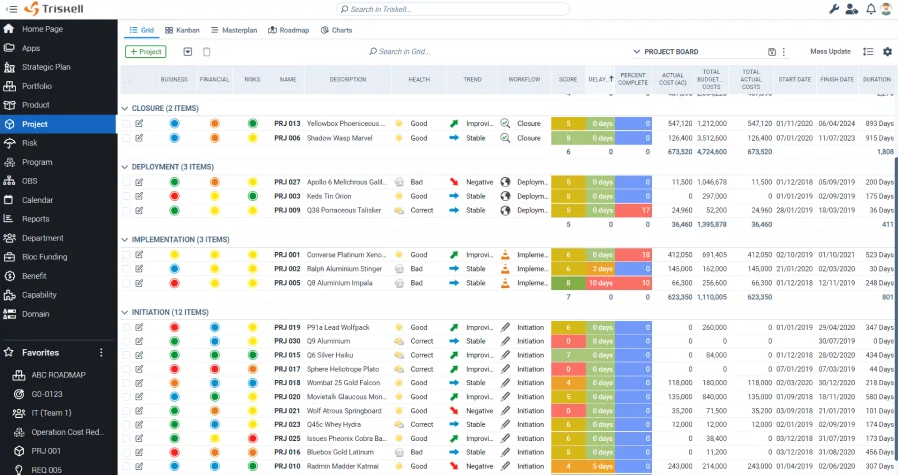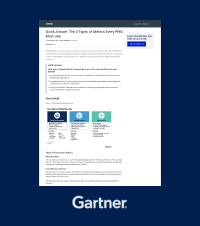The ultimate guide to strategic portfolio management - linking PPM with strategic goals

Strategic Portfolio Management has become an essential component for those organizations seeking to align their project and product portfolios with their business objectives and, in this way, obtain a higher ROI and a competitive advantage in the markets.
However, there are more than a few challenges that must be addressed to successfully implement the different components that make up Strategic Portfolio Management. In this post you will learn:
- The main differences between Strategic Portfolio Management and Project Portfolio Management.
- The main benefits of Strategic Portfolio Management.
- A series of good practices for its correct implementation.
- The importance of having a PPM software with Strategic Portfolio Management capabilities for the correct implementation of the process.
TABLE OF CONTENTS
- Strategic Portfolio Management vs Project Portfolio Management.
- Components of Strategic Portfolio Management framework.
- Benefits of Strategic Portfolio Management.
- Strategic Portfolio Management challenges.
- Strategic Portfolio Management capabilities in Triskell Software.
- Conclusion: ready to embrace the new PPM era?
Strategic Portfolio Management vs Project Portfolio Management
20 years. That is how long the concept of Project Portfolio Management (PPM) has been resonating with us since, back in 2005, it was first mentioned in the book “Project Portfolio Management: Selecting and Prioritizing Projects for Competitive Advantage”, written by James Pennypacker and Lowel D. Dye.

STRATEGIC PORTFOLIO MANAGEMENT
Align your project portfolios with business strategy
Discover Triskell Software’s Strategic Portfolio Management solution.
During this time, Project Portfolio management has had to evolve. Due to the increasing complexity of companies and the fierce competition in the markets, a more strategic and holistic management of the Project Portfolio has become increasingly necessary. In other words, whereas during the last two decades, PPM focused on prioritizing those projects that would result in the highest profitability for companies in the shortest possible time, strategic objectives must now be at the center of all PPM processes.
It is in this context when the concept of Strategic Portfolio Management (SPM) arises. An evolution of the traditional PPM processes that provides companies with a totally new way of planning and executing their strategies more efficiently and effectively.
What is Strategic Portfolio Management? Introducing the PPM 2.0 era
But before we continue, let’s go to the essentials: what is Strategic Portfolio Management?
As Gartner explains, Strategic Portfolio Management is “a set of business capabilities, processes and technologies” that support the creation “of a portfolio of strategic options that focus an organization’s finite resources” to execute business strategy across the corporation.
Strategic Portfolio Management involves all PPM processes (project selection and prioritization, resource management, capacity planning, risk management, budget management, etc.). And its main objective is to refine and improve decision-making in all these processes so that an organization’s project and product portfolios are aligned with its strategic objectives.
A process that, if well implemented, will help companies overcome some of the barriers they face in aligning strategy and execution.
SUBSCRIBE TO OUR NEWSLETTER
Get stories like this in your inbox
Key differences between Strategic Portfolio Management and Project Portfolio Management
Although they share many similarities, Strategic Portfolio Management differs from Project Portfolio Management in aspects such as scope, objectives, vision and decision making.
Project Portfolio Management |
Strategic Portfolio Management |
|
|---|---|---|
|
Focus
|
It focuses on the efficient management of projects and programs so that they are completed on time and on budget, and are aligned with the organization's overall objectives. |
It focuses on aligning project portfolios with strategic objectives. It involves assessing the objectives and potential of projects to maximize the achievement of those objectives. |
|
Scope
|
It focuses on the individual management of the projects that make up each portfolio of the organization, with special emphasis on project selection and prioritization, resource allocation and risk and dependencies management. |
It considers project portfolios and capacity planning as a whole. It evaluates the strategic fit of initiatives to optimize the Resource Management of each project portfolio. |
|
Vision
|
It takes a more short and medium-term view, focusing on the life cycle of projects from inception to completion. |
By focusing on the organization's strategic objectives, its vision is more global and long-term. |
|
Decision-making
|
Decision-making takes place at the project or program level, such as project prioritization, resource allocation or financial management. |
It involves decision making at the portfolio level and even at the C-Level to ensure that project portfolios are correctly prioritized and aligned with strategic objectives. |
The importance of aligning PPM processes with strategic goals
As you can see, all the elements that differentiate Strategic Portfolio Management from Project Portfolio Management revolve around strategic alignment. Decisions made in areas such as project selection and prioritization, resource management, risk and budget management should have a single purpose: to support the achievement of business goals and vision.
Ensure that project portfolios align with the overall strategic goals and objectives of the organization
And why is it important to adopt this approach when planning and managing strategy? There are many benefits to be gained by aligning all PPM processes with strategic objectives, and here are some of them:
- Management by objectives.
- Better resource usage.
- Risk mitigation.
- Vision 360º of project portfolios performance.
- Better adaptability and agility.
We will go more in depth about them later when analyzing the main benefits of Strategic Portfolio Management.
Components of Strategic Portfolio Management framework
Now, how can PMOs prioritize strategic projects according to their strategic importance? How can they allocate the necessary resources efficiently to these strategic initiatives? How can organizations cascade business objectives to all teams and departments so that everyone is working towards achieving them?
WHITE PAPER
Strategic Planning: From scrap head to moon shot
It is necessary to create a framework for Strategic Portfolio Management that helps to connect the selection and prioritization of incoming demand with the objectives. It is a 5-step process, which we explain below:
- Define your strategic objectives: Defining strategic objectives is the first step to establishing a solid process. These objectives will guide you in selecting and prioritizing projects. Then, it is important to link them to project results and efficiently communicate the strategy to stakeholders. Using a framework such as OKR will allow you to monitor results in real time and adjust priorities according to business needs.
- Align investments and capacity with strategic planning: by establishing a roadmap with clear objectives you will optimize your decision-making in areas such as budget management, capacity planning and resource management. By aligning investments with strategy, you can allocate the right funds to the most relevant projects, ensuring that the most valuable initiatives get the budgets they deserve.
- Get total visibility in real-time. To succeed in Strategic Portfolio Management, it is crucial to eliminate information silos and use tools that enable traceability between objectives, portfolio prioritization and results. Many organizations still rely on spreadsheets or inefficient PPM solutions. It is necessary to have PPM software that integrates SPM functionalities to plan strategies and operations, allocate resources and funds, prioritize cost-effective projects and eliminate information silos.
- Adopt a hybrid management approach. When implementing Strategic Portfolio Management, it is essential to be able to choose the most appropriate methodology for each project. However, few PPM tools allow switching between methodologies on the same platform. This flexibility is crucial to connect the work performed with business objectives, accelerate time to market and meet customer and stakeholder expectations.
- Adaptive and continuous management. Strategic Portfolio Management is a process of continuous improvement, very necessary in today’s competitive environment. It involves regularly reviewing the strategic planning, performance, resources, funds and risks of each project portfolio. This ability to adapt to change without compromising performance is essential for successful project portfolio management.
Ensure that project portfolios align with the overall strategic goals and objectives of the organization
Benefits of Strategic Portfolio Management
Once you have followed the necessary steps to implement an efficient Strategic Portfolio Management process in your organization, it is important to keep in mind the tangible benefits that this framework can offer you. There are 5 in total:
- Focus on strategic initiatives. Strategic portfolio management will be your best ally to choose and prioritize the projects that best fit your strategic objectives. By being clear about which projects have the greatest potential to deliver value to the business, you will be assured that these key initiatives will be allocated the financial and human resources they really need.
- Increased project portfolio success rate. By prioritizing initiatives based on their strategic value, you increase the probability of project success. Simply allocating the most valuable resources to key initiatives will help improve the overall success rate of projects in the portfolios most critical to your organization.
Drive strategic alignment and project visibility
Schedule a personalized demo and discover how Triskell can help you bridge the gap between strategy and execution.
- Accurate decision making. If you think about it, business objectives will serve as a guide on which to articulate a structured decision-making framework. After all, these objectives are what will guide you in making consistent decisions about whether each project is aligned with the long-term vision of the organization. Ultimately, less margin for error = greater value delivery.
- Greater business agility. Objectives are not static, and even less so in these times, when changes in market or industry trends can force companies to modify their roadmap. A framework such as Strategic Portfolio Management alone enables the continuous review of project portfolios. It provides the flexibility to re-prioritize initiatives according to your needs, so as not to lose responsiveness in today’s dynamic business environment.
- 360º vision in Resource and Budget Management. Thanks to Strategic Portfolio Management, aspects such as Capacity Planning or Budget Management can be planned with a view to the strategic importance of each project portfolio. You will optimize your resource allocation processes and prevent your most valuable resources from spending time on initiatives that do not contribute significantly to the achievement of objectives.
Strategic Portfolio Management challenges
While Strategic Portfolio Management offers numerous benefits to organizations, it also presents several challenges that must be addressed to ensure its success. From strategic goal alignment to resource optimization or risk management, each challenge requires careful attention and effective solutions to achieve successful strategic portfolio management.
These are the main challenges that organizations must overcome to achieve successful Strategic Portfolio Management:
- Establish clear criteria for project prioritization.
- Coping with resource constraints.
- Implement an efficient risk management process.
- Create a governance and decision-making framework.
- Successfully addressing Change Management.
- Lack of full visibility of data related to project portfolio management and strategic planning.
1. Establish clear criteria for project prioritization
There are many factors to consider when establishing criteria for project prioritization, such as:
- Strategic alignment.
- Financial viability.
- Risk level.
- Availability of resources.
- Market opportunity.
These are criteria that, in certain situations, can lead to conflicts of interest among the different stakeholders of the organization. Moreover, the fact that strategic objectives are evolving faster and faster means that these criteria need to be reviewed from time to time.
So, how to approach this challenge successfully? You must follow these steps:
- Create a framework of agreement with all stakeholders involved in project portfolio planning and management to define these criteria.
- Establish a single Demand Management platform from which to select or prioritize the next projects you will work on.
- Review these criteria regularly to ensure they are always aligned with the objectives of the organization.
- Conducts pilot projects or scenario simulations to test and refine selection criteria.
PPM SOFTWARE CHECKLIST
A Comprehensive buyer’s checklist for PPM Software
Use this quick checklist to compare potential modern PPM solutions in order to pick the best one for your organization.
2. Coping with resource constraints
Resource constraints are the bread and butter of any PMO. In addition to the complexity of allocating a limited number of resources to multiple project portfolios, there are other issues that further complicate this process, such as:
- Projects that overlap on time and require the simultaneous availability of resources, which can cause delays and bottlenecks in their execution.
- Capacity constraints due to lack of adequate skills or technology to satisfactorily execute projects.
- The uncertainty and changes in strategy that are so typical in these times, which can impact on the availability of resources and modify the allocation of resources.
To face this challenge, some strategies can be followed. These are just a few of them:
- Prioritize projects and resource allocation based on strategic objectives.
- Implement capacity planning and resource optimization processes. This includes assessing resource availability, identifying gaps and using continuous improvement processes for resource allocation.
- Adopt a more agile and flexible approach to resource allocation and make the necessary adjustments according to the needs and priorities of each project.
WEBINAR
How to manage resource constraints in a multi-portfolio environment
3. Implement an efficient risk management process
There are more and more risks that can affect the proper performance of your project portfolios. Here we list just a few of them:
- Risks associated with the project schedule and deadlines.
- Risks linked with resource availability.
- Risks associated with possible changes in project scope, which may result in increased costs.
- Financial risks.
- Technological risks.
- External risks (changes in market trends, natural disasters, political and economic instability, etc.).
For efficient strategy planning and management, it is now more necessary than ever to establish a risk management framework for organizations to identify, assess, mitigate and monitor risks.
This risk management framework should include:
- A risk assessment process at both project and portfolio level.
- Another process to monitor and report risks detected in each project portfolio.
- Defined risk mitigation strategies that include contingency plans and risk transfer or diversification mechanisms.
- Artifacts that enable learning and continuous improvement in your risk management practices.
Drive strategic alignment and project visibility
Schedule a personalized demo and discover how Triskell can help you bridge the gap between strategy and execution.
4. Create a governance and decision-making framework
There are many factors that hinder organizations from creating a solid governance framework. For example:
- The complexity and scale of project portfolios: the more complex the project portfolios, the more careful you need to be in assigning roles, responsibilities, decision-making authority and communication channels.
- Reaching a point of consensus with all stakeholders: all parties involved in the planning and execution of the strategy have their interests and points of view. Reaching consensus with all of them is key to defining a clear governance framework for all.
- Create a consistent decision-making process: the more complex the organization, the more roles are involved in decision-making. Designing a governance framework that satisfies the criteria, priorities and biases of all decision-makers is key to efficient Strategic Portfolio Management.
To make this task more manageable, organizations should identify key stakeholders and draw up a responsibility assignment matrix (RACI). This document will help you to delimit the responsibilities of each one of them in the different activities of each project portfolio.
Define a governance structure with well-defined roles, responsibilities, and decision-making processes
Collaboration and communication should also be encouraged. You should enable environments in which each stakeholder can contribute their points of view and actively participate in all activities related to decision making.
5. Successfully addressing Change Management
Any change implemented at the portfolio level will involve changes in processes, roles and responsibilities. This is the perfect environment for strong resistance to these changes from individuals or teams who do not want to change their established ways of working.
To address this resistance to change, organizations must:
- Develop a communication plan outlining key messages (and tailored for each stakeholder group), communication channels and an implementation timeline.
- Assess each stakeholder’s readiness to change in order to identify in advance possible obstacles or counteracting agents.
- Align changes with the existing organizational culture by detecting those cultural aspects that may hinder the change process and developing strategies to correct them.
WHITE PAPER
Creatures that slow down portfolio delivery and how to kill them
6. Lack of full visibility of data related to project portfolio management and strategic planning
Many organizations do not have the data visibility with which to link strategic objectives to the results of their product and project portfolios. It is very common that in many companies the information is segregated in different applications, or that must spend hours and hours filling in spreadsheets to have minimally updated data of their project portfolios.
This, as you may already know, has very negative consequences for the business, such as:
- Lack of strategic alignment: if the objectives are not clear or have not been communicated efficiently, it is very difficult to determine which projects and programs are key or not for the business.
- Inaccurate decision making: without this visibility, organizations lose focus of the projects underway and the value they bring to the business. This can lead to suboptimal decision making due to the lack of information on project portfolios.
- Inefficient resource and fund allocation: without clear visibility of strategic objectives and the use of resources being made, resource overutilization and bottlenecks will be very common scenarios in your organization.
- Inconsistent reporting and dashboards: With data fragmented across different systems or spreadsheets, many top-level executives will not have access to the reports they need to accurately analyze business performance.
To overcome this lack of visibility, many organizations rely on ‘traditional’ PPM solutions, thinking that this will give them a 360º view to connect strategic objectives with the value delivered by each project portfolio. Unfortunately, this is not the case. You can hardly number the PPM software with the necessary functionalities to obtain a strategic view of the execution of project portfolios on the fingers of one hand.
Maintain a centralized and secure repository for all portfolio-related data, ensuring easy access and consistency
Therefore, it is imperative that companies renew their suite of PPM tools with other solutions that do integrate Strategic Portfolio Management capabilities. And one of those few tools that does is Triskell Software.
Strategic Portfolio Management capabilities in Triskell Software
Triskell Software is a PPM tool with Strategic Portfolio Management capabilities to capture, align and link objectives, initiatives, programs and portfolios across the enterprise to keep business challenges under control and ensure results.
These are some of the benefits that Triskell Software will bring to your organization:
- 360º vision of project portfolios: Triskell Software will be your single source of truth when it comes to data on project portfolios, strategic objectives, budget management or resource allocation. You’ll gain the visibility and transparency you need to make informed decisions based on real-time data.
- Prioritization of deliverables aligned with strategic objectives: Triskell’s Strategic Portfolio Management capabilities include a wide range of planning tools such as Scoring models, Masterplan and Scenario Simulations. Now you can prioritize each project, program or portfolio according to its strategic value.
- Plan ahead with Scenario Simulations: you can analyze and simulate different planning and management scenarios. This will allow you to assess in advance the impact of possible changes in project prioritization, fund allocation or resource allocation and thus maximize the performance of your strategic portfolios.
- Resource Management and Capacity Planning in a single tool: Triskell also includes functionalities for capacity planning and resource planning and allocation at project, program or portfolio level. You will be able to identify gaps and bottlenecks in advance and ensure that key resources are allocated to the highest value initiatives.
- Integration with your organization’s application ecosystem: Jira, Microsoft Project, Teams, Salesforce, Microsoft Dynamics… You can integrate Triskell with any of the applications in your organization’s IT ecosystem. All data related to project portfolio management will be within your reach.
- Customizable reports and dashboards: configure reports and dashboards according to your needs. Provide stakeholders with the information they really need to understand the value that project portfolios are bringing to your organization and facilitate decision making.
- Foster collaboration and communication among all stakeholders: you will have at your disposal document sharing functionalities, real-time alerts and notifications, comments and discussion boards for each business object, etc. This way you can improve collaboration between teams and ensure that they are aligned with the organization’s objectives.
EBOOK
PPM Software Buyers’ Guide
What should you look for in a new PPM tool?
Conclusion: ready to embrace the new PPM era?
In an increasingly competitive and dynamic business environment, Strategic Portfolio Management has become a key factor for organizational success. Throughout this post, we have explored the fundamentals of Strategic Portfolio Management, from its differentiation from Project Portfolio Management to its key components and benefits. We have also examined the main challenges that organizations face when implementing this practice.
Now it’s your turn. Reflect on your organization’s needs, assess the challenges and consider the advantages that Strategic Portfolio Management can bring you. Are you ready to make the leap into the new era of PPM? If you are committed to the long-term success of your business and want to make the most of your resources, it’s time to consider implementing a strategic approach to all your PPM processes.
SUBSCRIBE TO OUR NEWSLETTER
Get stories like this in your inbox
Request a demo of Triskell Software
Want to learn more? Request a free demo of Triskell Software and you will discover the PPM software that best suits your business needs.
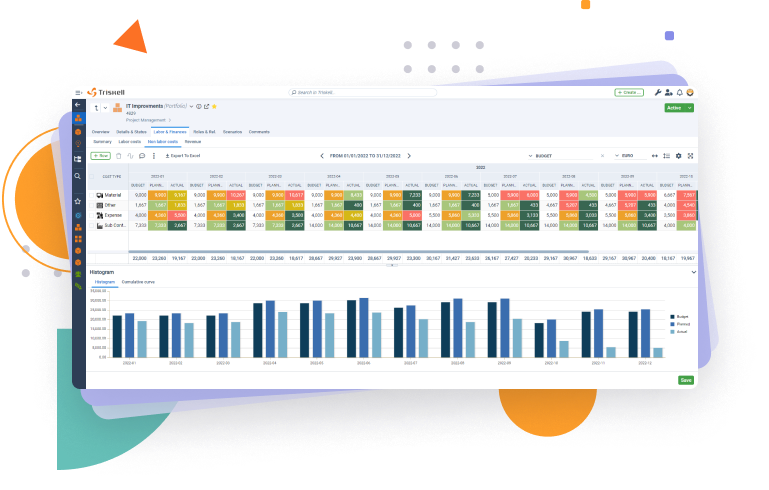
FAQs about Strategic Portfolio Management
What are the benefits of Strategic Portfolio Management?
Strategic Portfolio Management (SPM) offers several advantages, including:
- Improved alignment with strategic goals: SPM ensures projects directly contribute to the organization’s overall strategy, maximizing return on investment.
- Enhanced decision-making: By providing a 360-degree view of the portfolio, SPM facilitates informed decisions on project selection, prioritization, and resource allocation.
- Increased agility: SPM allows organizations to adapt to changing priorities and market conditions by continuously reviewing and adjusting the portfolio.
- Optimized resource utilization: SPM helps organizations make the most of their limited resources by focusing on high-value projects.
How does Strategic Portfolio Management differ from Project Portfolio Management (PPM)?
While SPM and PPM are related, they have distinct focuses:
- Strategic Portfolio Management: Focuses on aligning project portfolios with strategic objectives. It assesses projects’ potential to maximize achievement of those objectives.
- Project Portfolio Management: Focuses on the individual management of projects within a portfolio. It emphasizes project selection, prioritization, resource allocation, risk management, and dependency management.
What is the process for Strategic Portfolio Management?
Strategic Portfolio Management typically involves a 5-step process:
- Define strategic objectives: Establish the organization’s vision, mission, and key strategic goals.
- Identify potential initiatives: Brainstorm and identify projects, programs, and other initiatives that could contribute to the strategic objectives.
- Evaluate and prioritize initiatives: Assess each initiative’s potential benefits, risks, alignment with strategy, and resource requirements. Prioritize initiatives based on this evaluation.
- Select the optimal portfolio: Choose the set of initiatives that best aligns with the organization’s strategic goals and resource constraints.
- Continuously monitor and adapt: Regularly review the portfolio’s performance, adjust resource allocation as needed, and adapt the portfolio to changing circumstances.
What tools and technologies can support Strategic Portfolio Management?
Several software solutions like Triskell Software can support Strategic Portfolio Management (SPM) by:
- Facilitating the definition and communication of strategic objectives.
- Providing tools for evaluating and prioritizing initiatives.
- Helping with portfolio visualization and resource allocation.
- Enabling collaboration and communication among stakeholders.
Related Content
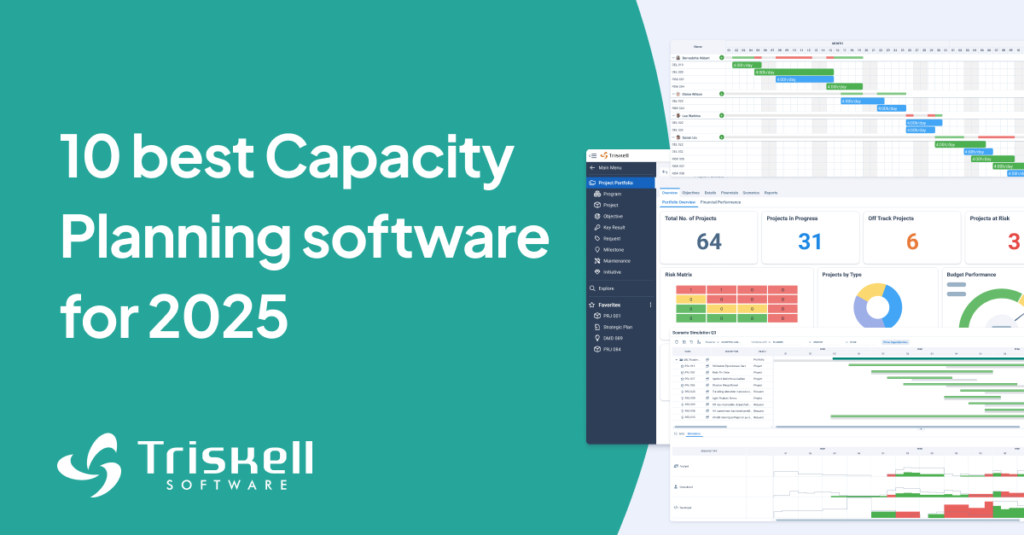
10 best Capacity Planning software & tools in 2025: the ultimate guide
Blog 10 best Capacity Planning software & tools in 2025: the ultimate guide Today, efficient capacity planning and resource management is essential for any organization

7 challenges in new product development and best practices to address them
In this post you will learn some best practices to tackle the major challenges in new product development, from idea validation to quality control.
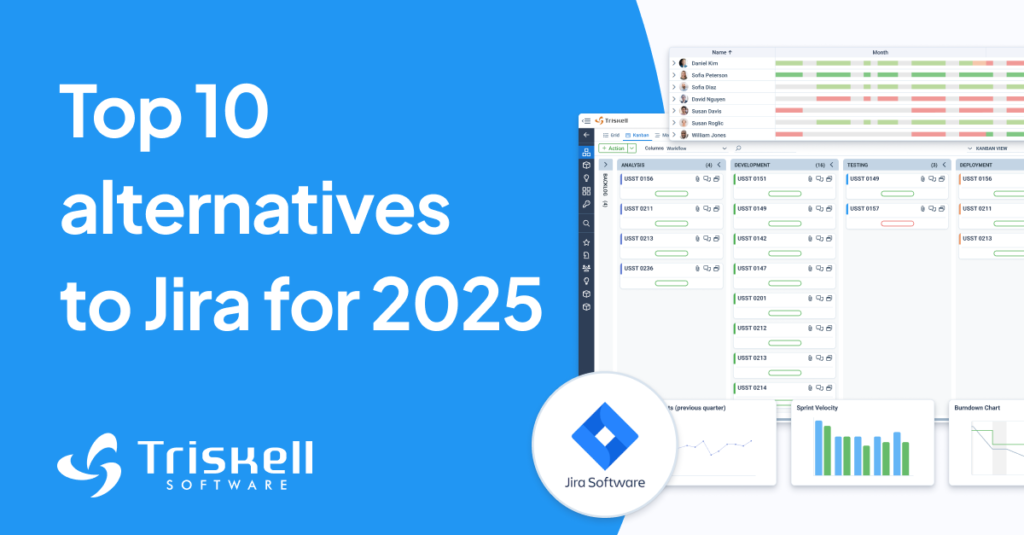
10 best competitors and alternatives to Jira in 2025
Jira is one of the most used tools by medium and large companies. But is it better than Triskell for managing multiple portfolios?
